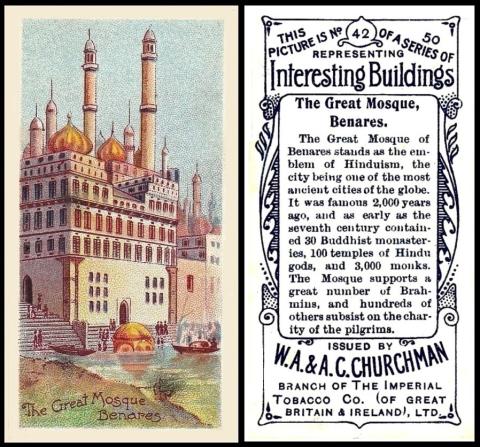
Here we have "The Great Mosque, Benares". In fact it seems unlikely that it was ever known by that name, and Benares, too, is no more, it is now Varanasi, in the Uttar Pradesh region of India.
When the Mosque was first constructed, around 1669, it was done so by the conqueror of the region, Aurangzeb. He built it at the most prominent place in the area, right on the Ganges, and he also made a most impressive set of steps that went right down into the river. He called it Alamgir Mosque, because he was the Alamgir, which was the honorary title he had given himself on becoming the emperor of the Mughals.
Some time after he had gone, it started to be called by his own name, Aurangzeb, or Aurangzeb`s Mosque. Then it started to fall into disrepair. The two tall towers, showing here on this card, were first to go. They were restored, in the nineteenth century, by someone who, in most sources, is simply called "an Englishman", or sometimes "an Englishman with a love for history". Actually he was a bit more important than that, he was James Prinsep, FRS, the founding editor of the Journal of the Asiatic Society of Bengal, who was amazingly talented at translating early texts and papers, and in fact we owe a great deal of our current knowledge about the region, and its historical significance, to him.
Despite his efforts, the minarets again began to crumble, and in 1948 one tumbled down, killing some people beneath it. I am struck by the way that this is reported in a very matter of fact way, when really it was quite shocking. Later the other one was demolished, by the government, for what is called, curiously, "reasons of security"
Anyway, this is the earliest card that we can so far tie down to having been issued in the month of July.
It first appears in our original reference book to Churchman issues, RB.10, published in 1948, as :
- 77. July 1905. 50. INTERESTING BUILDINGS. (titled series). Size 2 11/16" x 1 7/16" or 67 x 36 m/m. Numbered 1-50. Fronts lithographed in colour. Backs in blue, with descriptions. Printed by Mardon, Son & Hall. Also issued by Hignett, Mitchell, Williams and Wills (Australia)
Now we have featured all but one of these versions (the Mitchell) elsewhere on this website, but always within a newsletter. So as this is the first time it has been a Card of the Day, and, fortuitously, it is not only the first issuer if they are listed in alphabetical order, but the earliest version to be issued. Anyway all that means is this page inherits the mantle of being the home page for the entire group. And if you want to read the specifics of the others, here is where you will find them.
| Issuer | Date | Link | scroll to |
| Churchman : | July 1905 - | https://csgb.co.uk/cardoftheday/2025-07-08 | |
| Hignett : | July 1905 - | https://csgb.co.uk/publications/newsletter/2024-06-01 | - Wednesday, 5th June |
| Mitchell : | 1905 - | ||
| W. Williams : | 1912 - | https://csgb.co.uk/publications/newsletter/2023-02-04 | - Tuesday, 7th February |
| "Capstan" (wills) : |
1905 - | https://csgb.co.uk/publications/newsletter/2023-06-03 | - Wednesday, 7th June |
At this point, I must point out that the back designs on the Churchman, Hignett, Mitchell and Williams sets are the same, apart from the single curving line of type that gives their name, though the Mitchell line does not curve quite so spectacularly. However, the "Capstan" version, which does not mention "Wills" anywhere, is similar to the sides but has a block panel at the bottom. Some time I will get a block made of all of the backs to show this better.
If we return to our version, it next appears in our original World Tobacco Issues Index, as :
- INTERESTING BUILDINGS. Sm. Nd. (50). See H.70. ... C82-23.
This text is identical in our updated version of that work, save a new card code of C504-300
